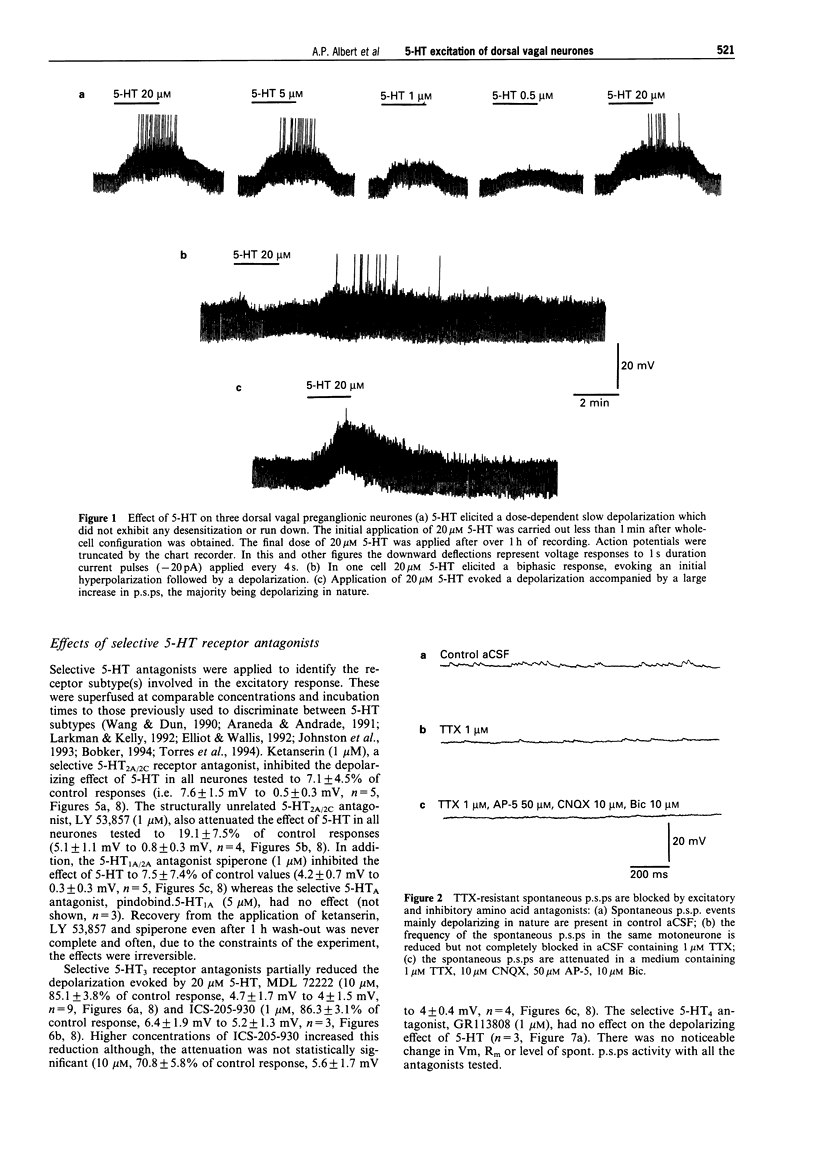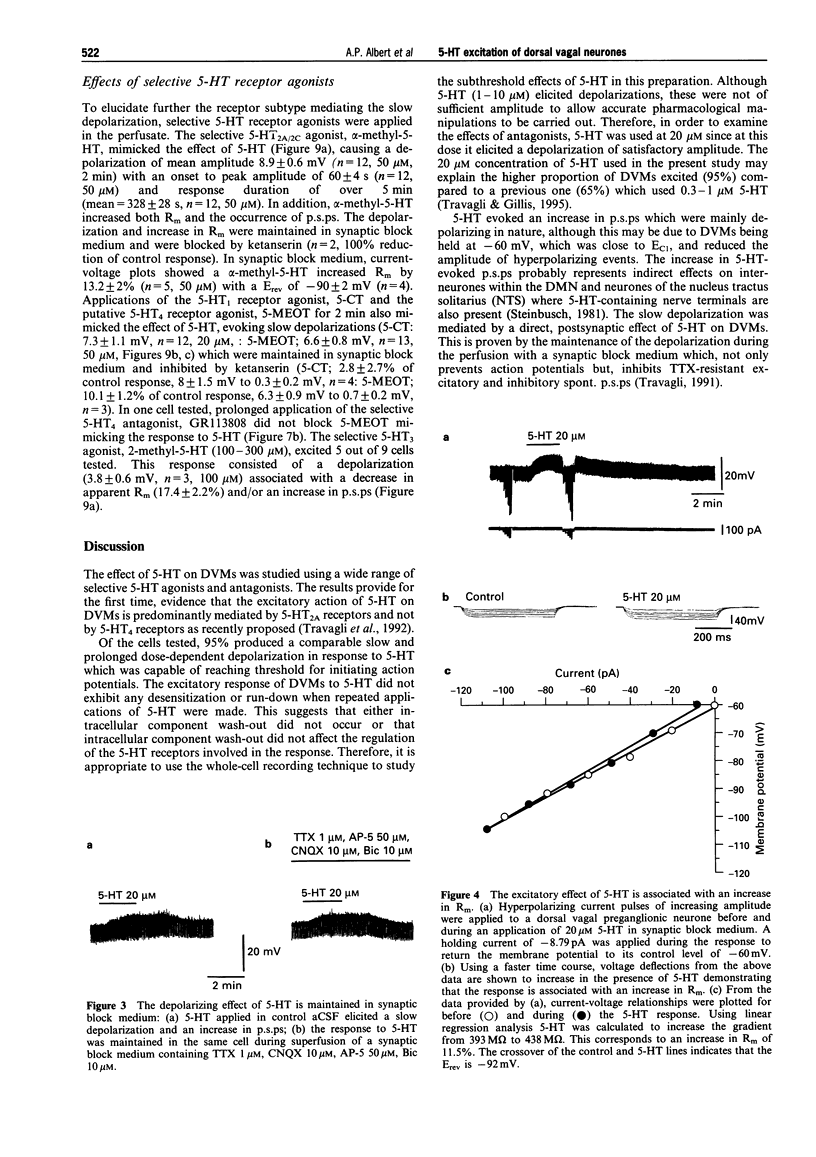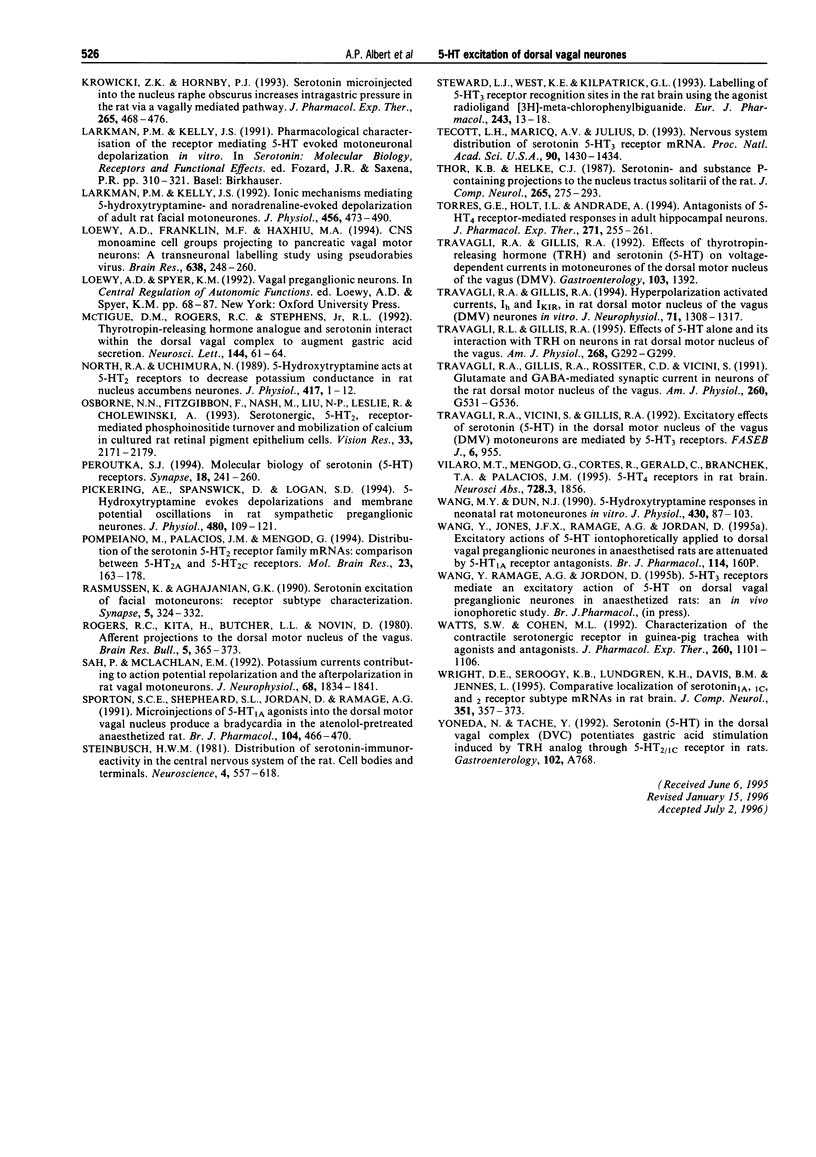Abstract
1. Whole-cell patch-clamp recordings were made from 142 visually identified rat dorsal vagal preganglionic neurones (DVMs). Applications of 5-hydroxytryptamine (5-HT, 20 microM, 2 min) elicited a slow depolarization (8.2 +/- 0.5 mV, n = 59) in 95% of the cells tested, accompanied by an increase in excitability. In (68%) of DVMs the depolarization was associated with an increase in apparent membrane resistance (Rmt 22.7 +/- 2.2%). These depolarizations and increases in Rm (14.3 +/- 2.6%, n = 8) were maintained in a medium which blocked synaptic transmission. 2. The response to 5-HT was associated with a reversal potential (Erev) of -91 +/- 1 mV at an extracellular K+ concentration (LK+]o) of 4.2 mM. This correlated well with the K+ equilibrium potential (Ek = -89 mV). 3. The depolarizing effect of 5-HT was attenuated by the 5-HT2A/2C receptor antagonists, ketanserin (1 microM), LY 53,857 (1 microM) and the 5-HT1A/2A receptor antagonist, spiperone (1 microM). The 5-HT1A receptor antagonist, pindobind 5-HT1A (5 microM), had no effect on the depolarizing response to 5-HT. 4. The effect of 5-HT was mimicked by the 5-HT2A/2C receptor agonist, alpha-methyl-5-HT (50 microM), the 5-HT1 receptor agonist, 5-carboxamidotryptamine (20 microM) and the putative 5-HT4 agonist, 5-methyoxytryptamine (5 microM). The selective 5-HT4 receptor antagonist, GR113808, had no effect on the depolarizing effect of 5-HT or 5-MEOT on DVMs. 5. The 5-HT3 antagonists, MDL 72222 (10 microM) and ICS-205-930 (1 and 10 microM), partially reduced the effect of 5-HT. The 5-HT3 receptor agonist, 2-methyl-5-HT (100-300 microM), excited a proportion of neurones tested (56%) by evoking a depolarizing and/or an increase in postsynaptic potentials (p.s.ps). 6. These results are consistent with direct, postsynaptic actions of 5-HT on DVMs via 5-HT2A receptors, being mediated, in part, by the reduction of K+ conductance.
Full text
PDF







Selected References
These references are in PubMed. This may not be the complete list of references from this article.
- Araneda R., Andrade R. 5-Hydroxytryptamine2 and 5-hydroxytryptamine 1A receptors mediate opposing responses on membrane excitability in rat association cortex. Neuroscience. 1991;40(2):399–412. doi: 10.1016/0306-4522(91)90128-b. [DOI] [PubMed] [Google Scholar]
- Bobker D. H. A slow excitatory postsynaptic potential mediated by 5-HT2 receptors in nucleus prepositus hypoglossi. J Neurosci. 1994 Apr;14(4):2428–2434. doi: 10.1523/JNEUROSCI.14-04-02428.1994. [DOI] [PMC free article] [PubMed] [Google Scholar]
- Bobker D. H., Williams J. T. Serotonin augments the cationic current Ih in central neurons. Neuron. 1989 Jun;2(6):1535–1540. doi: 10.1016/0896-6273(89)90041-x. [DOI] [PubMed] [Google Scholar]
- Bockaert J., Sebben M., Dumuis A. Pharmacological characterization of 5-hydroxytryptamine4(5-HT4) receptors positively coupled to adenylate cyclase in adult guinea pig hippocampal membranes: effect of substituted benzamide derivatives. Mol Pharmacol. 1990 Mar;37(3):408–411. [PubMed] [Google Scholar]
- Eglen R. M., Wong E. H., Dumuis A., Bockaert J. Central 5-HT4 receptors. Trends Pharmacol Sci. 1995 Nov;16(11):391–398. doi: 10.1016/s0165-6147(00)89081-1. [DOI] [PubMed] [Google Scholar]
- Elliott P., Wallis D. I. Serotonin and L-norepinephrine as mediators of altered excitability in neonatal rat motoneurons studied in vitro. Neuroscience. 1992;47(3):533–544. doi: 10.1016/0306-4522(92)90163-v. [DOI] [PubMed] [Google Scholar]
- Glaum S. R., Brooks P. A., Spyer K. M., Miller R. J. 5-Hydroxytryptamine-3 receptors modulate synaptic activity in the rat nucleus tractus solitarius in vitro. Brain Res. 1992 Aug 28;589(1):62–68. doi: 10.1016/0006-8993(92)91162-8. [DOI] [PubMed] [Google Scholar]
- Hoyer D., Clarke D. E., Fozard J. R., Hartig P. R., Martin G. R., Mylecharane E. J., Saxena P. R., Humphrey P. P. International Union of Pharmacology classification of receptors for 5-hydroxytryptamine (Serotonin). Pharmacol Rev. 1994 Jun;46(2):157–203. [PubMed] [Google Scholar]
- Johnston A. R., Murnion B., McQueen D. S., Dutia M. B. Excitation and inhibition of rat medial vestibular nucleus neurones by 5-hydroxytryptamine. Exp Brain Res. 1993;93(2):293–298. doi: 10.1007/BF00228397. [DOI] [PubMed] [Google Scholar]
- Krowicki Z. K., Hornby P. J. Serotonin microinjected into the nucleus raphe obscurus increases intragastric pressure in the rat via a vagally mediated pathway. J Pharmacol Exp Ther. 1993 Apr;265(1):468–476. [PubMed] [Google Scholar]
- Larkman P. M., Kelly J. S. Ionic mechanisms mediating 5-hydroxytryptamine- and noradrenaline-evoked depolarization of adult rat facial motoneurones. J Physiol. 1992 Oct;456:473–490. doi: 10.1113/jphysiol.1992.sp019347. [DOI] [PMC free article] [PubMed] [Google Scholar]
- Loewy A. D., Franklin M. F., Haxhiu M. A. CNS monoamine cell groups projecting to pancreatic vagal motor neurons: a transneuronal labeling study using pseudorabies virus. Brain Res. 1994 Feb 28;638(1-2):248–260. doi: 10.1016/0006-8993(94)90657-2. [DOI] [PubMed] [Google Scholar]
- McTigue D. M., Rogers R. C., Stephens R. L., Jr Thyrotropin-releasing hormone analogue and serotonin interact within the dorsal vagal complex to augment gastric acid secretion. Neurosci Lett. 1992 Sep 14;144(1-2):61–64. doi: 10.1016/0304-3940(92)90716-k. [DOI] [PubMed] [Google Scholar]
- North R. A., Uchimura N. 5-Hydroxytryptamine acts at 5-HT2 receptors to decrease potassium conductance in rat nucleus accumbens neurones. J Physiol. 1989 Oct;417:1–12. doi: 10.1113/jphysiol.1989.sp017786. [DOI] [PMC free article] [PubMed] [Google Scholar]
- Osborne N. N., Fitzgibbon F., Nash M., Liu N. P., Leslie R., Cholewinski A. Serotonergic, 5-HT2, receptor-mediated phosphoinositide turnover and mobilization of calcium in cultured rat retinal pigment epithelium cells. Vision Res. 1993 Nov;33(16):2171–2179. doi: 10.1016/0042-6989(93)90097-g. [DOI] [PubMed] [Google Scholar]
- Peroutka S. J. Molecular biology of serotonin (5-HT) receptors. Synapse. 1994 Nov;18(3):241–260. doi: 10.1002/syn.890180310. [DOI] [PubMed] [Google Scholar]
- Pickering A. E., Spanswick D., Logan S. D. 5-Hydoxytryptamine evokes depolarizations and membrane potential oscillations in rat sympathetic preganglionic neurones. J Physiol. 1994 Oct 1;480(Pt 1):109–121. doi: 10.1113/jphysiol.1994.sp020345. [DOI] [PMC free article] [PubMed] [Google Scholar]
- Pompeiano M., Palacios J. M., Mengod G. Distribution of the serotonin 5-HT2 receptor family mRNAs: comparison between 5-HT2A and 5-HT2C receptors. Brain Res Mol Brain Res. 1994 Apr;23(1-2):163–178. doi: 10.1016/0169-328x(94)90223-2. [DOI] [PubMed] [Google Scholar]
- Rasmussen K., Aghajanian G. K. Serotonin excitation of facial motoneurons: receptor subtype characterization. Synapse. 1990;5(4):324–332. doi: 10.1002/syn.890050409. [DOI] [PubMed] [Google Scholar]
- Rogers R. C., Kita H., Butcher L. L., Novin D. Afferent projections to the dorsal motor nucleus of the vagus. Brain Res Bull. 1980 Jul-Aug;5(4):365–373. doi: 10.1016/s0361-9230(80)80006-2. [DOI] [PubMed] [Google Scholar]
- Sah P., McLachlan E. M. Potassium currents contributing to action potential repolarization and the afterhyperpolarization in rat vagal motoneurons. J Neurophysiol. 1992 Nov;68(5):1834–1841. doi: 10.1152/jn.1992.68.5.1834. [DOI] [PubMed] [Google Scholar]
- Sporton S. C., Shepheard S. L., Jordan D., Ramage A. G. Microinjections of 5-HT1A agonists into the dorsal motor vagal nucleus produce a bradycardia in the atenolol-pretreated anaesthetized rat. Br J Pharmacol. 1991 Oct;104(2):466–470. doi: 10.1111/j.1476-5381.1991.tb12452.x. [DOI] [PMC free article] [PubMed] [Google Scholar]
- Steinbusch H. W. Distribution of serotonin-immunoreactivity in the central nervous system of the rat-cell bodies and terminals. Neuroscience. 1981;6(4):557–618. doi: 10.1016/0306-4522(81)90146-9. [DOI] [PubMed] [Google Scholar]
- Steward L. J., West K. E., Kilpatrick G. J., Barnes N. M. Labelling of 5-HT3 receptor recognition sites in the rat brain using the agonist radioligand [3H]meta-chlorophenylbiguanide. Eur J Pharmacol. 1993 Oct 12;243(1):13–18. doi: 10.1016/0014-2999(93)90161-a. [DOI] [PubMed] [Google Scholar]
- Tecott L. H., Maricq A. V., Julius D. Nervous system distribution of the serotonin 5-HT3 receptor mRNA. Proc Natl Acad Sci U S A. 1993 Feb 15;90(4):1430–1434. doi: 10.1073/pnas.90.4.1430. [DOI] [PMC free article] [PubMed] [Google Scholar]
- Thor K. B., Helke C. J. Serotonin- and substance P-containing projections to the nucleus tractus solitarii of the rat. J Comp Neurol. 1987 Nov 8;265(2):275–293. doi: 10.1002/cne.902650210. [DOI] [PubMed] [Google Scholar]
- Torres G. E., Holt I. L., Andrade R. Antagonists of 5-HT4 receptor-mediated responses in adult hippocampal neurons. J Pharmacol Exp Ther. 1994 Oct;271(1):255–261. [PubMed] [Google Scholar]
- Travagli R. A., Gillis R. A. Effects of 5-HT alone and its interaction with TRH on neurons in rat dorsal motor nucleus of the vagus. Am J Physiol. 1995 Feb;268(2 Pt 1):G292–G299. doi: 10.1152/ajpgi.1995.268.2.G292. [DOI] [PubMed] [Google Scholar]
- Travagli R. A., Gillis R. A. Hyperpolarization-activated currents, IH and IKIR, in rat dorsal motor nucleus of the vagus neurons in vitro. J Neurophysiol. 1994 Apr;71(4):1308–1317. doi: 10.1152/jn.1994.71.4.1308. [DOI] [PubMed] [Google Scholar]
- Travagli R. A., Gillis R. A., Rossiter C. D., Vicini S. Glutamate and GABA-mediated synaptic currents in neurons of the rat dorsal motor nucleus of the vagus. Am J Physiol. 1991 Mar;260(3 Pt 1):G531–G536. doi: 10.1152/ajpgi.1991.260.3.G531. [DOI] [PubMed] [Google Scholar]
- Wang M. Y., Dun N. J. 5-Hydroxytryptamine responses in neonate rat motoneurones in vitro. J Physiol. 1990 Nov;430:87–103. doi: 10.1113/jphysiol.1990.sp018283. [DOI] [PMC free article] [PubMed] [Google Scholar]
- Watts S. W., Cohen M. L. Characterization of the contractile serotonergic receptor in guinea pig trachea with agonists and antagonists. J Pharmacol Exp Ther. 1992 Mar;260(3):1101–1106. [PubMed] [Google Scholar]
- Wright D. E., Seroogy K. B., Lundgren K. H., Davis B. M., Jennes L. Comparative localization of serotonin1A, 1C, and 2 receptor subtype mRNAs in rat brain. J Comp Neurol. 1995 Jan 16;351(3):357–373. doi: 10.1002/cne.903510304. [DOI] [PubMed] [Google Scholar]


